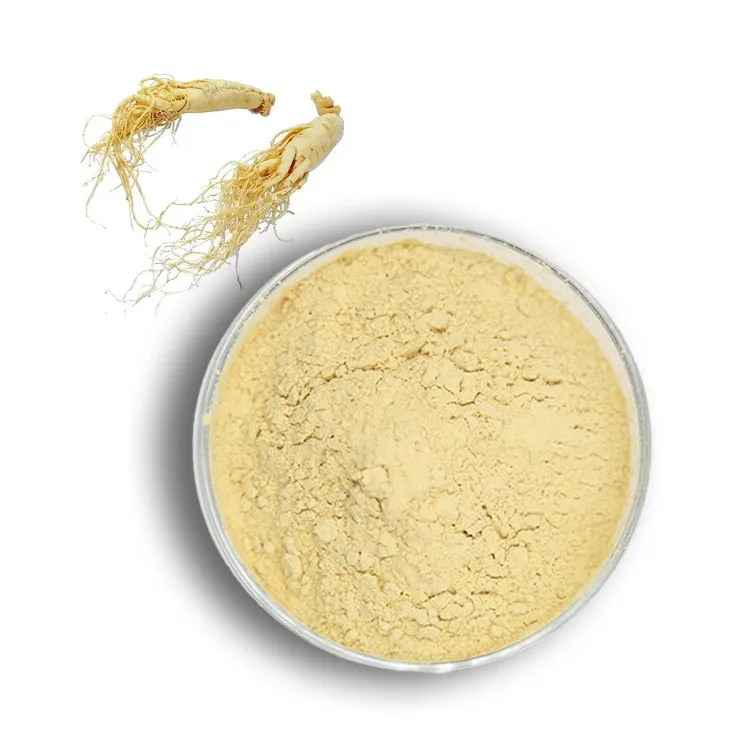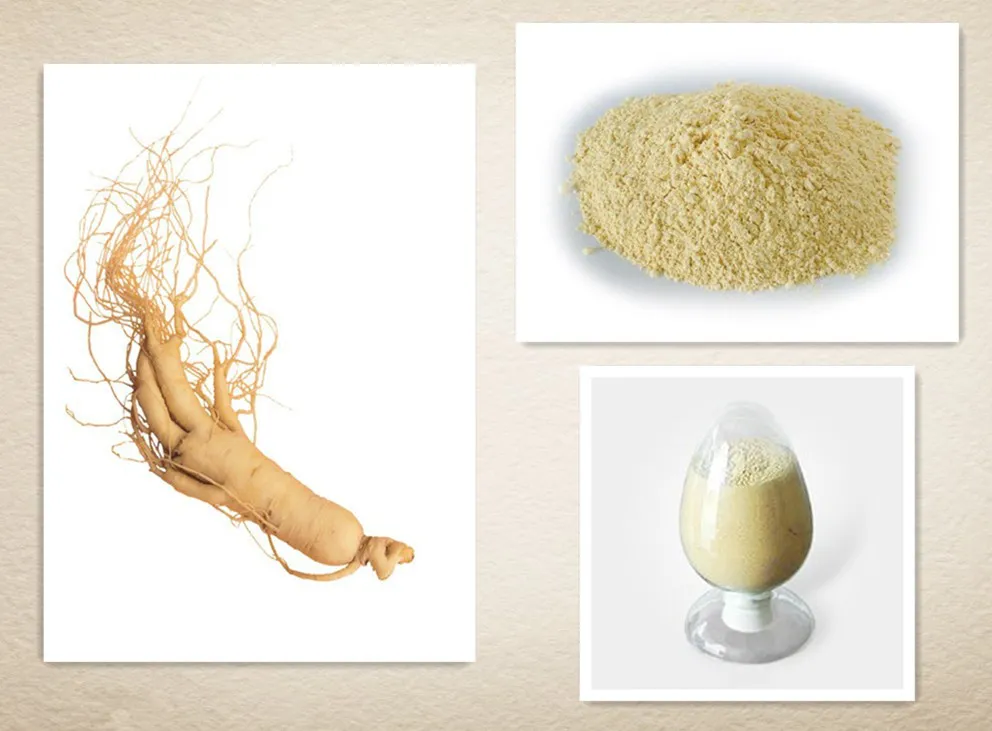- 0086-571-85302990
- sales@greenskybio.com
How to make powder from ginseng root extract?
2024-11-28

1. Introduction
Ginseng has been highly valued in traditional medicine for centuries due to its numerous potential health benefits. Ginseng Root Extract powder is a convenient form for consumption and for use in various products such as dietary supplements, cosmetics, and herbal remedies. The process of making powder from Ginseng Root Extract involves several important steps, each of which requires careful attention to ensure the quality and potency of the final product.

2. Preparation of Ginseng Root
2.1 Harvesting
The first step in obtaining Ginseng Root Extract is the proper harvesting of the ginseng roots. Ginseng is a slow - growing plant, and it is crucial to wait until the roots have reached an appropriate maturity level. In general, ginseng roots are typically harvested after 3 - 6 years of growth, depending on the species and growing conditions. Harvesting too early may result in a lower concentration of active compounds in the root.
2.2 Cleaning
Once harvested, the ginseng roots need to be thoroughly cleaned. Remove any dirt, debris, or other foreign materials adhering to the roots. This can be done by gently brushing the roots under running water. It is important to be careful during this process not to damage the roots, as any damage may affect the quality of the extract.
2.3 Drying
After cleaning, the ginseng roots should be dried. Drying helps to preserve the roots and also concentrates the active compounds. There are different methods of drying, such as air - drying and oven - drying. Air - drying is a more traditional method and is carried out by hanging the roots in a well - ventilated area out of direct sunlight. This process can take several weeks. Oven - drying, on the other hand, is a faster method. Set the oven to a low temperature, typically around 40 - 50°C, and dry the roots until they are brittle. Make sure to monitor the drying process closely to prevent over - drying or burning of the roots.

3. Extraction of Ginseng Root
3.1 Solvent Selection
The choice of solvent for extraction is a critical factor. Different solvents can extract different types of compounds from the ginseng root. Commonly used solvents include water, ethanol, and methanol. Water extraction is a more natural and safe method, suitable for extracting water - soluble compounds such as polysaccharides. Ethanol and methanol are better for extracting lipophilic compounds such as ginsenosides. However, when using ethanol or methanol, proper safety precautions must be taken due to their flammability and toxicity.
3.2 Extraction Process
Once the solvent is selected, the extraction process can begin. There are two main types of extraction methods: maceration and percolation. Maceration involves soaking the dried ginseng roots in the solvent for a period of time, usually several days to weeks. The solvent is then filtered to obtain the extract. Percolation is a continuous extraction method where the solvent is slowly passed through a column filled with the ginseng roots. This method is more efficient and can result in a higher yield of extract. During the extraction process, temperature control is important. Maintaining a relatively low temperature, typically around room temperature or slightly above, can help to preserve the integrity of the active compounds.

4. Purification (if necessary)
4.1 Filtration
After extraction, the ginseng root extract may contain impurities such as undissolved plant material, dirt, or other contaminants. Filtration is the first step in purification. Use a filter with an appropriate pore size to remove these large - sized impurities. For example, a filter paper or a mesh filter can be used. This helps to obtain a cleaner extract.
4.2 Centrifugation
Centrifugation can be used to further purify the extract. By spinning the extract at high speeds in a centrifuge, smaller particles and impurities can be separated from the extract. This process can improve the clarity and purity of the extract.
4.3 Chromatography (Optional)
In some cases, chromatography techniques may be employed for more advanced purification. For example, high - performance liquid chromatography (HPLC) can be used to separate and purify specific compounds in the ginseng root extract, such as different ginsenoside isomers. However, chromatography techniques are more complex and require specialized equipment and expertise.

5. Transformation into Powder Form
5.1 Evaporation
To transform the ginseng root extract into powder, the first step is usually evaporation. This is done to remove the solvent from the extract. There are different evaporation methods, such as rotary evaporation and vacuum evaporation. Rotary evaporation is a commonly used method in the laboratory. The extract is placed in a round - bottomed flask and rotated while being heated gently under reduced pressure. This allows the solvent to be evaporated efficiently. Vacuum evaporation is also effective and can be carried out using a vacuum evaporator. By reducing the pressure, the solvent can be evaporated at a lower temperature, which is beneficial for preserving the active compounds in the extract.
5.2 Drying and Grinding
After evaporation, the remaining solid extract is usually still in a semi - solid or gummy state. It needs to be further dried to obtain a dry powder. This can be done in an oven at a low temperature or using a freeze - dryer for better preservation of the active compounds. Once the extract is completely dry, it can be ground into a fine powder using a mortar and pestle or a mechanical grinder. The powder should be sieved through a fine - mesh sieve to ensure a uniform particle size.

6. Significance of Temperature Control
Temperature control plays a crucial role throughout the process of making ginseng root extract powder. During extraction, as mentioned earlier, maintaining a relatively low temperature helps to preserve the active compounds in the ginseng root. High temperatures can cause degradation of some of the heat - sensitive compounds, such as ginsenosides. During evaporation and drying, temperature control is also important. If the temperature is too high during evaporation, it may lead to the loss of volatile compounds or the degradation of active compounds. Similarly, during drying, excessive heat can cause the powder to become hard and less bioavailable.
7. Equipment Choice
The choice of equipment is another important factor in the production of ginseng root extract powder. For extraction, depending on the scale of production, different types of equipment can be used. For small - scale extraction, a simple glassware setup for maceration or percolation may be sufficient. However, for larger - scale production, more advanced extraction equipment such as Soxhlet extractors or continuous extraction systems may be required. For evaporation, rotary evaporators are commonly used in laboratories, while industrial - scale production may use large - volume vacuum evaporators. For drying, ovens or freeze - dryers are available, and the choice depends on the requirements for quality and cost. For grinding, mortar and pestle can be used for small - scale production, while mechanical grinders are more suitable for larger - scale production.
8. Conclusion
Making powder from ginseng root extract is a multi - step process that requires careful attention to detail. From the preparation of the ginseng root to the final transformation into powder form, each step has its own significance and challenges. Temperature control and equipment choice are important factors that can affect the quality and potency of the final product. By following the proper procedures and taking into account these factors, it is possible to produce high - quality ginseng root extract powder for various applications in the fields of medicine, cosmetics, and dietary supplements.
FAQ:
Q1: What are the initial steps in preparing ginseng root for extract powder?
First, select high - quality ginseng roots. Wash them thoroughly to remove any dirt or impurities. Then, they may need to be dried partially or completely depending on the extraction method. This initial preparation ensures that the ginseng root is in an optimal state for further processing.
Q2: Why might extraction purification be necessary when making ginseng root extract powder?
Extraction purification is often necessary because ginseng roots contain various components, some of which may be unwanted or may interfere with the quality of the final powder. Purification helps to isolate the beneficial compounds, such as ginsenosides, and remove substances like pesticides, heavy metals, or other contaminants that could be present in the raw root.
Q3: What role does temperature control play in the production of ginseng root extract powder?
Temperature control is crucial. During extraction, different temperatures can affect the solubility of the compounds in the solvent used. If the temperature is too high, it may degrade some of the active ingredients in ginseng, like ginsenosides. During drying to form powder, appropriate temperature control ensures that the powder is formed without losing its potency and without the growth of microorganisms.
Q4: How do you choose the right equipment for making ginseng root extract powder?
The choice of equipment depends on several factors. For extraction, you need equipment that can efficiently break down the cell walls of the ginseng root to release the active compounds. This could be a grinder or a specialized extraction device. For purification, filtration equipment is required. And for drying to form powder, a dehydrator or a freeze - dryer might be suitable depending on the scale of production and the desired quality of the powder. Consider factors like cost, efficiency, and ease of operation when choosing equipment.
Q5: What are the common solvents used for ginseng root extraction?
Common solvents include water, ethanol, and methanol. Water is a natural and safe solvent, but it may not be as effective in extracting all the compounds as compared to alcohols. Ethanol is often preferred as it can extract a wide range of compounds including ginsenosides, and it is relatively safe and easy to handle. Methanol is also used in some cases, but it is more toxic and requires careful handling.
Related literature
- Ginseng Root Extract: Production and Quality Control"
- "Advanced Techniques in Ginseng Root Extract Powder Manufacturing"
- "The Science behind Ginseng Root Extraction and Powder Formation"
- ▶ Hesperidin
- ▶ citrus bioflavonoids
- ▶ plant extract
- ▶ lycopene
- ▶ Diosmin
- ▶ Grape seed extract
- ▶ Sea buckthorn Juice Powder
- ▶ Beetroot powder
- ▶ Hops Extract
- ▶ Artichoke Extract
- ▶ Reishi mushroom extract
- ▶ Astaxanthin
- ▶ Green Tea Extract
- ▶ Curcumin Extract
- ▶ Horse Chestnut Extract
- ▶ Other Problems
- ▶ Boswellia Serrata Extract
- ▶ Resveratrol Extract
- ▶ Marigold Extract
- ▶ Grape Leaf Extract
- ▶ blog3
- ▶ blog4
-
The best olive leaf extract in nature.
2024-11-28
-
Cordyceps extract suppliers.
2024-11-28
-
Chinese aguaje extract powder manufacturers.
2024-11-28
-
Honeysuckle pollen of the best quality.
2024-11-28
-
Chinese Senna Leaf Extract Suppliers.
2024-11-28
-
Organic Dandelion Root Extract, Australia.
2024-11-28
-
The best bitter gourd extract in 2024.
2024-11-28
-
The best baicalin in nature.
2024-11-28
-
Rose Hip Extract
2024-11-28
-
Mangosteen extract powder
2024-11-28
-
Sugarcane Extract
2024-11-28
-
Curcuma Longa Extract
2024-11-28
-
Aguaje Extract
2024-11-28
-
Dandelion Leaf Extract
2024-11-28
-
Gynostemma pentaphyllum extract
2024-11-28
-
Fig Extract
2024-11-28
-
Rosemary extract
2024-11-28
-
Senna Leaf Extract
2024-11-28





















